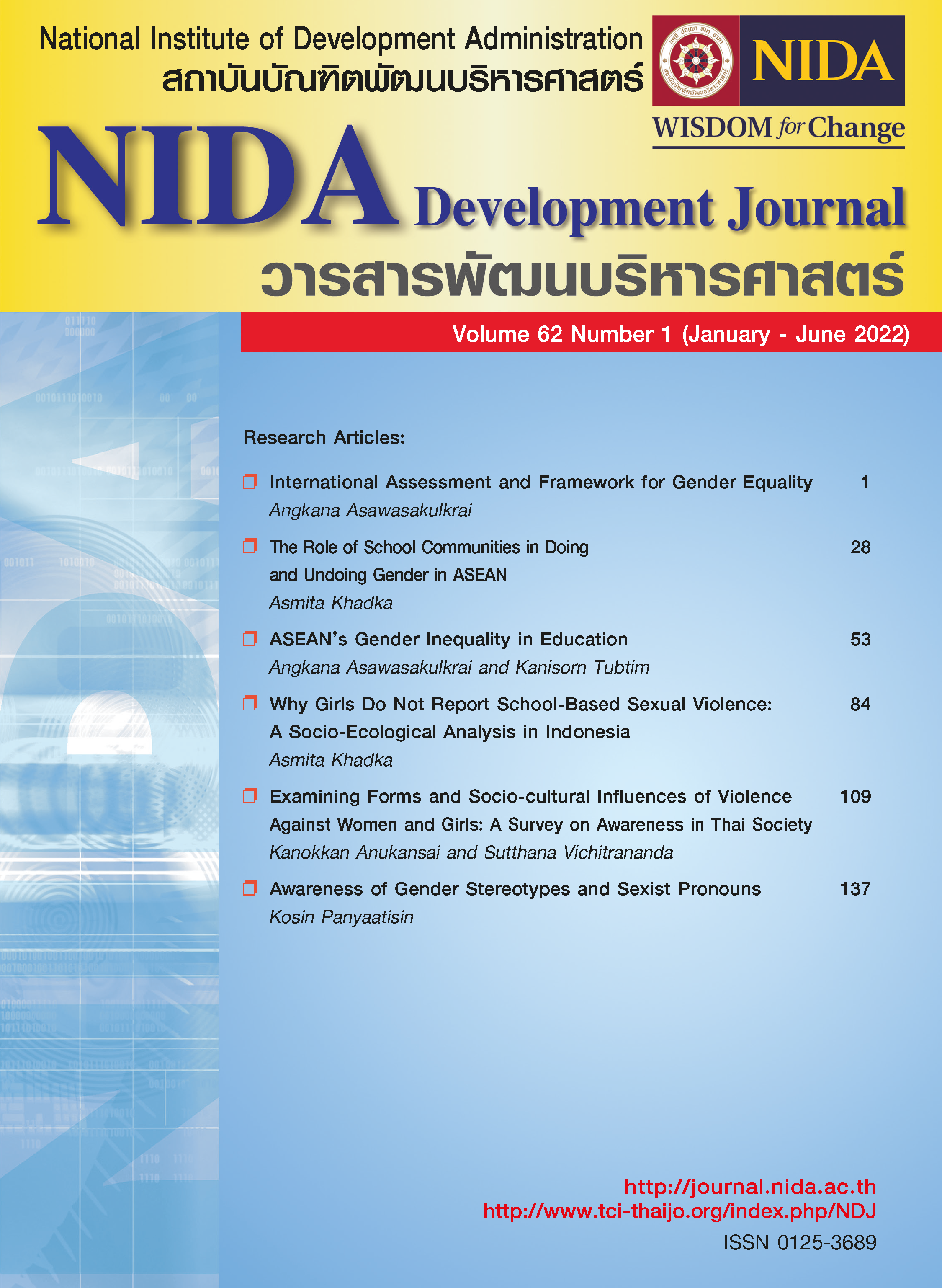Why Girls Do Not Report School-based Sexual Violence: A Socio-ecological Analysis in Indonesia
Keywords:
School-related sexual violence, Culture of silence, Child sex abuse disclosure, Ecological modelAbstract
Disclosure of sexual violence against children is often the first step to providing support to the victims. It is also essential for addressing impunity for sexual violence crimes and discouraging future violations. While there has been ample research on Childhood Sexual Abuse (CSA) disclosure, the focus on school-related sexual violence against children and adolescence is largely missing. This paper explores factors that prevent female students from disclosing school-related sexual violence in Indonesia using Bronfenbrenner (1977)’s ecological model. Based on a secondary analysis of the data gathered through four Focus Group Discussions (FDGs) involving high school and undergraduate students, experts, teachers, and lecturers, the factors preventing the disclosure of sexual violence at four levels of the victim’s environment were identified. The findings support that nondisclosure of school-related sexual violence is a result of complex interactions between the victims and their environmental contexts.
References
Adu, J., & Oudshoorn, A. (2020). The deinstitutionalization of psychiatric hospitals in Ghana: An application of Bronfenbrenner’s social-ecological model. Issues in Mental Health Nursing, 41(4), 306-314.
Alaggia, R., Collin-Vézina, D., & Lateef, R. (2019). Facilitators and barriers to child sexual abuse (CSA) disclosures: A research update (2000–2016). Trauma, Violence, & Abuse, 20(2), 260-283.
Bronfenbrenner, U. (1977). Toward an experimental ecology of human development. American Psychologist, 32(7), 513.
Davis, D. W., Pressley-McGruder, G., Jones, V. F., Potter, D., Rowland, M., Currie, M., & Gale, B. (2013). Evaluation of an innovative tool for child sexual abuse education. Journal of Child Sexual Abuse, 22(4), 379-397.
ECPAT, INTERPOL, and UNICEF. (2022). Disrupting Harm in Indonesia: Evidence on online child sexual exploitation and abuse. Global Partnership to End Violence Against Children.
Hershkowitz, I., Lanes, O., & Lamb, M. E. (2007). Exploring the disclosure of child sexual abuse with alleged victims and their parents. Child abuse & neglect, 31(2), 111-123.
Ivankova, N. V., & Plano Clark, V. L. (2018). Teaching mixed methods research: using a socio-ecological framework as a pedagogical approach for addressing the complexity of the field. International Journal of Social Research Methodology, 21(4), 409-424.
Klein, J. (2006). An invisible problem: Everyday violence against girls in schools. Theoretical criminology, 10(2), 147-177.
Levendosky, A. A., & Graham-Bermann, S. A. (2001). Parenting in battered women: The effects of domestic violence on women and their children. Journal of family violence, 16(2), 171-192.
McKillop, N. (2019). Understanding the nature and dimensions of child sexual abuse to inform its prevention. In Child Abuse and Neglect (pp. 241-259). Academic Press.
Michell, D., Szabo, C., Falkner, K., & Szorenyi, A. (2018). Towards a socio-ecological framework to address gender inequity in computer science. Computers & Education, 126, 324-333.
Mootz, J. J., Stabb, S. D., & Mollen, D. (2017). Gender-based violence and armed conflict: a community-informed socioecological conceptual model from Northeastern Uganda. Psychology of Women Quarterly, 41(3), 368-388.
Noer, K. U., Chadijah, S., & Rudiatin, E. (2021). There is no trustable data: the state and data accuracy of violence against women in Indonesia. Heliyon, 7(12), e08552.
Pedroso, M. R. D. O., & Leite, F. M. C. (2022). Prevalence and factors associated with sexual violence against children in a Brazilian State. International journal of environmental research and public health, 19(16), 9838.
Rumble, L., Febrianto, R. F., Larasati, M. N., Hamilton, C., Mathews, B., & Dunne, M. P. (2020). Childhood sexual violence in Indonesia: a systematic review. Trauma, violence, & abuse, 21(2), 284-299.
Shtarkshall, R. A., Baynesan, F., & Feldman, B. S. (2009). A socio-ecological analysis of Ethiopian immigrants’ interactions with the Israeli healthcare system and its policy and service implications. Ethnicity & health, 14(5), 459-478.
Skarbek, D., Hahn, K., & Parrish, P. (2009). Stop sexual abuse in special education: An ecological model of prevention and intervention strategies for sexual abuse in special education. Sexuality and Disability, 27(3), 155-164.
Stromquist, N. P. (2007). The gender socialization process in schools: A cross-national comparison. Background Paper Prepared for the Education for All Global Monitoring Report 2008.
Swick, K. J., & Williams, R. D. (2006). An analysis of Bronfenbrenner’s bio-ecological perspective for early childhood educators: Implications for working with families experiencing stress. Early childhood education journal, 33(5), 371-378.
Timmerman, G. (2003). Sexual harassment of adolescents perpetrated by teachers and by peers: An exploration of the dynamics of power, culture, and gender in secondary schools. Sex roles, 48(5), 231-244.
UNICEF. (2014). Hidden in plain sight- A statistical analysis of violence against children. Retrieved November 15, 2022 from https://data.unicef.org/resources/hidden-in-plain-sight-a-statistical-analysis-of-violence-against-children/
UNESCO & UN Women. (2016). Global guidance on addressing school-related gender-based violence. Retrieved November 15, 2022 from https://www.unwomen.org/sites/default/files/Headquarters/Attachments/Sections/Library/Publications/2016/Global-guidance-on-addressing-school-related-gender-based-violence-en.pdf
UNODC. (2019). Topic three - The right of victims to an adequate response to their needs. Retrieved January 6, 2023 from https://www.unodc.org/e4j/zh/crime-prevention-criminal-justice/module-11/key-issues/3--the-right-of-victims-to-an-adequate-response-to-their-needs.html
Vichit-Vadakan, J., Jaturongkachoke, K., Anukansai, K., Vichitrananda, S., Khadka, A., Asawasakulkrai, A. (2021). Chapter 5- Promoting Gender Sensitive Education. In Gender Equality in Education: An ASEAN Sourcebook (pp 104-127). Retrieved January 6, 2023 from http://www.cpcs.nida.ac.th/home/pdf/gen_en.pdf
WHO & Pan American Health Organization. (2012). Understanding and addressing violence against women. Retrieved November 16, 2022 from https://apps.who.int/iris/bitstream/handle/10665/77432/WHO_RHR_12.36_eng.pdf?sequence=1&isAllowed=y
Wismayanti, Y. F., O’Leary, P., Tilbury, C., & Tjoe, Y. (2019). Child sexual abuse in Indonesia: A systematic review of literature, law and policy. Child abuse & neglect, 95, 104034.
Downloads
Published
How to Cite
Issue
Section
License
Copyright (c) 2023 NIDA Development Journal

This work is licensed under a Creative Commons Attribution-NonCommercial-NoDerivatives 4.0 International License.





